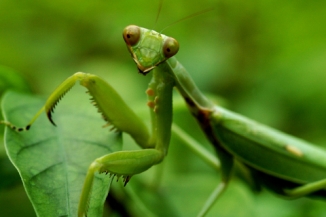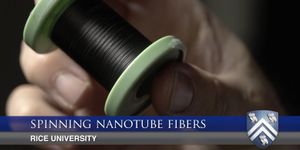Videos
Engineering Video
MAY 06, 2014 12:00 AM PDT
Share
Insect 3D Glasses for Depth Perception Research
 If we present a story with the terms "praying mantis" and "3D", you are probably going to assume you have wandered into the entertainment section by mistake and are expecting a review of a very bad movie. In this case, you would be wrong.
If we present a story with the terms "praying mantis" and "3D", you are probably going to assume you have wandered into the entertainment section by mistake and are expecting a review of a very bad movie. In this case, you would be wrong.Praying mantises do have a natural connection to 3D - they are the only known members of the invertebrate family that can perceive depth. This makes them unusually efficient hunters given the size of their brains and other natural limitations.
But how does their depth perception work? Is it similar to human depth perception, based on small differences in each of our eyes with respect to the location of an object, or is there some other mechanism involved?
This is a question with some fairly serious ramifications. If the mechanisms are the same, how did praying mantises come to develop them? It seems unlikely to be an evolutionary process, since no other invertebrate has this ability-unless we just haven't discovered it yet in other invertebrates. If the mechanisms are different, what is the other mechanism and does it have applicability in other fields?
For example, since the brain for the praying mantis is so small, it is likely that any other 3D vision mechanism is simpler in nature than ours-so that could lead to simpler algorithms for installing depth perception in robotic systems.
A group of vision scientists from Newcastle University are attempting to address this by studying the vision mechanism of praying mantises. They have concluded the first stage of this work, by creating the world's smallest sets of 3D glasses, which were attached to the heads of the praying mantises with beeswax.
The insects were then subjected to a monitor that generated classical 3D circles, using the traditional offset method of 3D movie projection. By altering this pattern, they are able to induce the mantises to strike at the circles, fooling them by altering their sense of depth perception with the glasses.
As much as this may sound like research cooked up over a few pints at the pub, it does provide an efficient method of measuring the effect on the mantises. By observing changes in the circles and corresponding changes in the strike pattern, the team can gain insight into how the mantises are locating and tracking 3D objects, and what the important factors and boundaries are.
For those of you who have to see what this looks like, you can find a video of this research from Newcastle University online - complete with one instance of slow-motion replay. You will have to add your own play-by-play commentary.
New efforts are underway to include different species of praying mantises, and gain more knowledge on praying mantis diversity while continuing the original line of research.
We leave you with one last thought - somebody can legitimately put on his or her resume that they stuck tiny 3D glasses on the heads of praying mantises and tried to fool them with visual cues. We are guessing that it will be phrased differently on the resume.
You May Also Like
Loading Comments...








